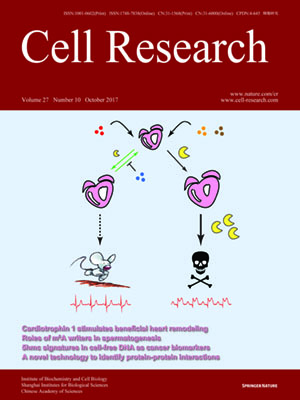
Volume 27, No 10, Oct 2017
ISSN: 1001-0602
EISSN: 1748-7838 2018
impact factor 17.848*
(Clarivate Analytics, 2019)
Volume 27 Issue 10, October 2017: 1275-1288
ORIGINAL ARTICLES
Cryo-EM structures of the 80S ribosomes from human parasites Trichomonas vaginalis and Toxoplasma gondii
Zhifei Li1,2, Qiang Guo1,*, Lvqin Zheng3,*, Yongsheng Ji4, Yi-Ting Xie5, De-Hua Lai5, Zhao-Rong Lun5, Xun Suo6 and Ning Gao1,3
1State Key Laboratory of Membrane Biology, Beijing Advanced Innovation Center for Structural Biology, School of Life Sciences, Tsinghua University, Beijing 100084, China;
2Tsinghua-Peking Joint Center for Life Sciences, Tsinghua University, Beijing 100084, China;
3State Key Laboratory of Membrane Biology, Peking-Tsinghua Joint Center for Life Sciences, School of Life Sciences, Peking University, Beijing 100871, China;
4Anhui Provincial Laboratory of Pathogen Biology, Anhui Key Laboratory of Zoonoses, Department of Microbiology and Parasitology, Anhui Medical University, Hefei, Anhui 230022, China;
5Center for Parasitic Organisms, State Key Laboratory of Biocontrol, Key Laboratory of Tropical Disease Control (Sun Yat-Sen University), Ministry of Education, School of Life Sciences, Sun Yat-Sen University, Guangzhou, Guangdong 510275, China;
6State Key Laboratory of Agrobiotechnology & National Animal Protozoa Laboratory, College of Veterinary Medicine, China Agricultural University, Beijing 100193, China
Correspondence: Ning Gao,(gaon@pku.edu.cn)
As an indispensable molecular machine universal in all living organisms, the ribosome has been selected by evolution to be the natural target of many antibiotics and small-molecule inhibitors. High-resolution structures of pathogen ribosomes are crucial for understanding the general and unique aspects of translation control in disease-causing microbes. With cryo-electron microscopy technique, we have determined structures of the cytosolic ribosomes from two human parasites, Trichomonas vaginalis and Toxoplasma gondii, at resolution of 3.2–3.4 Å. Although the ribosomal proteins from both pathogens are typical members of eukaryotic families, with a co-evolution pattern between certain species-specific insertions/extensions and neighboring ribosomal RNA (rRNA) expansion segments, the sizes of their rRNAs are sharply different. Very interestingly, rRNAs of T. vaginalis are in size comparable to prokaryotic counterparts, with nearly all the eukaryote-specific rRNA expansion segments missing. These structures facilitate the dissection of evolution path for ribosomal proteins and RNAs, and may aid in design of novel translation inhibitors.
10.1038/cr.2017.104
FULL TEXT | PDF
Browse 1713


